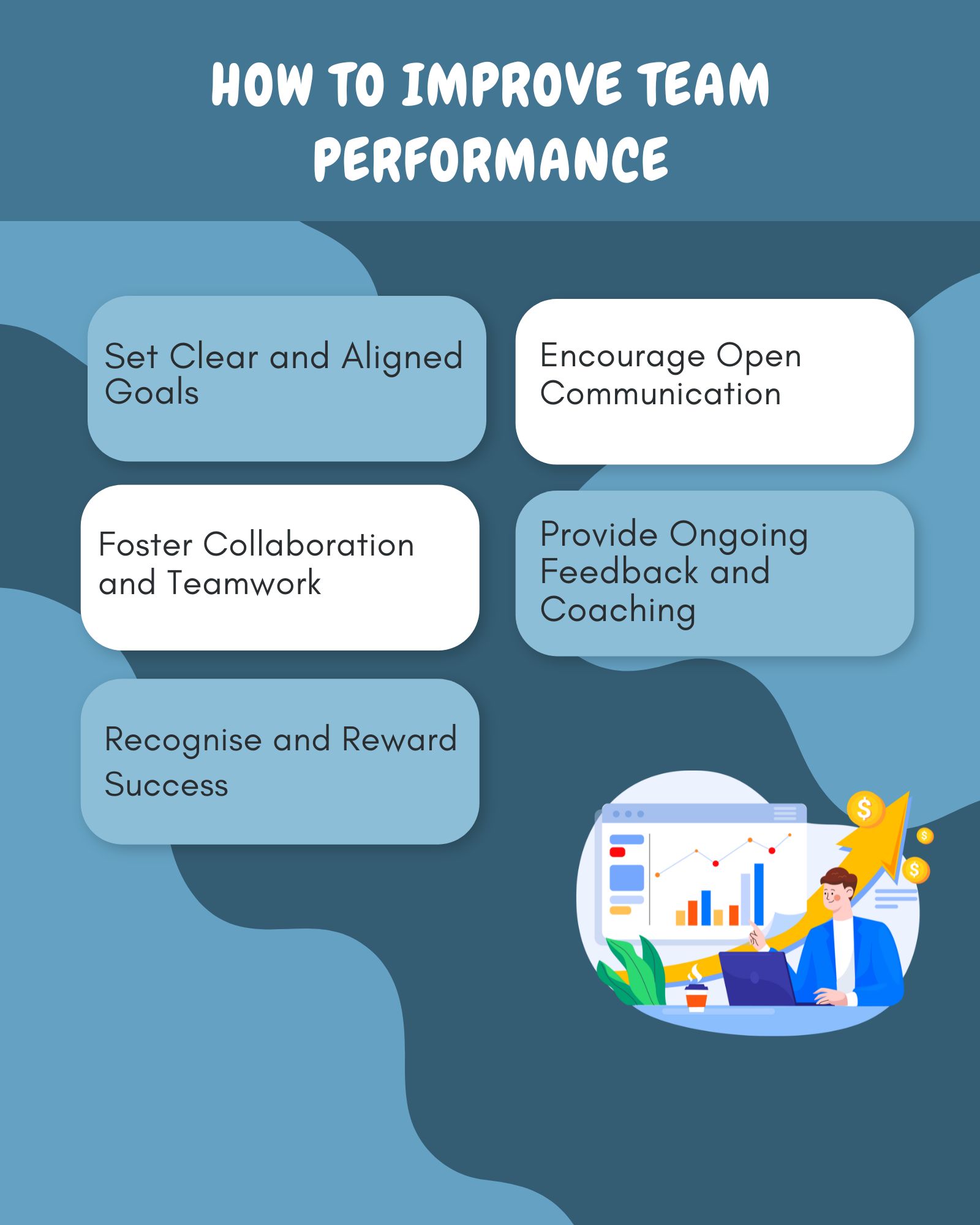- Table of Contents
- Introduction
- I. Understanding Performance and People's Performance
- A. What is Performance?
- B. People Performance
- II. Measuring People's Performance
- How Do We Measure People's Performance?
- Conduct Regular Performance Reviews
- Utilise 360-Degree Feedback
- Monitor Goal Achievement
- III. Team-based Performance vs. Individual-based Performance
- A. Individual-based Performance
- B. Team-based Performance
- IV. Importance of Team Performance Management
- V. Tips for Effective Team Performance Management
- B. How to Improve Team Performance
- Set Clear and Aligned Goals
- Encourage Open Communication
- Foster Collaboration and Teamwork
- Provide Ongoing Feedback and Coaching
- Recognise and Reward Success
- C. Developing Sustainable High-Performance Work Teams
- Invest in Training and Development
- Promote Diversity and Inclusion
- Empower Team Members
- D. Must-dos to Manage Day-to-Day Team Performance
- Monitor Progress Regularly
- Encourage Accountability
- Maintain Open Lines of Communication
- E. Utilise Technology to Support Performance Management
- Implement Performance Management Software
- Leverage Collaboration Tools
- Monitor and Analyse Data
- VI. Evaluating Team Performance
- A. Build a Continuous Feedback Loop
- Conduct Performance Reviews
- Encourage Peer Feedback
- B. Measure Performance Against Established Metrics
- Track Progress Toward Goals
- Analyse Performance Data
- Adjust Strategies as Needed
- VII. The Power of Gamification in Team Performance Management
- Understanding Gamification
- The Psychology Behind Gamification
- Applying Gamification to Team Performance
- Goal Setting and Achievement
- Competitions and Leaderboards
- Reward Systems
- Feedback and Progress Tracking
- Real-World Examples
- VIII. The Role of Psychological Safety in Team Performance
- The Link Between Psychological Safety and Performance
- Building Psychological Safety in Teams
- Leadership
- Conclusion
Introduction
Navigating the intricate terrain of today's competitive business landscape demands a profound appreciation for the art of team performance management. Understanding and harnessing the potential of individual and collective contributions is the linchpin of organisational triumph. This comprehensive guide delves into the dynamic realm of performance management. We explore the quintessence of performance, dissect the contrasting facets of individual-based and team-based performance, and equip you with actionable insights and strategies to elevate your team's prowess to unprecedented heights.
I. Understanding Performance and People's Performance
A. What is Performance?
Performance measures the extent to which an individual, team, or organisation accomplishes its goals and objectives. It encompasses many facets, including work quality, efficiency, effectiveness, and the capacity to adapt and evolve over time.
Consider a sales team aiming to achieve a specific revenue target. In this context, performance would be measured by the team's ability to meet or exceed the sales quota within a defined period. The quality of sales interactions, the efficiency of the sales process, and the team's ability to adapt to changing market conditions would all contribute to the team's overall performance.
B. People Performance
People's performance zeroes in on the contributions of individual employees or team members to the overarching success of the organisation. It involves meticulously evaluating their skills, knowledge, and behaviours to gauge their effectiveness in their roles and their impact on the team's overall success. Imagine a software development team tasked with delivering a new product. People's performance within this team would assess individual developers' coding skills, ability to collaborate in a team setting, and capacity to meet project deadlines. This individual performance analysis is essential, but it is only part of the larger picture.
II. Measuring People's Performance
How Do We Measure People's Performance?
Establish Clear Performance Metrics: The first step in measuring people's performance is to develop precise and quantifiable indicators that mirror the key aspects of an individual's role. These metrics can encompass productivity, quality of work, customer satisfaction, and deadline adherence. For example, if you manage a customer support team, you might measure individual performance by tracking the number of resolved customer issues and the average response time.
Conduct Regular Performance Reviews
Schedule periodic evaluations to assess progress, provide constructive feedback, and set new goals. These reviews should be a two-way conversation, allowing team members to share their insights and concerns. An effective performance review offers an opportunity for growth and development.
Utilise 360-Degree Feedback
Gather feedback from various sources, including peers, managers, and subordinates, to comprehensively understand an individual's performance. This holistic view can uncover blind spots and highlight areas for improvement that might otherwise go unnoticed.
Monitor Goal Achievement
Implement a system to track progress toward individual goals and objectives. Regularly revisiting these goals ensures that performance stays on track and provides opportunities for course correction when necessary.
III. Team-based Performance vs. Individual-based Performance
A. Individual-based Performance
Individual-based performance evaluation assesses each team member's contributions separately, emphasising their unique skills, knowledge, and behaviours. While this approach can effectively identify high-performing individuals, it may inadvertently sideline the significance of collaboration and teamwork in achieving overall team success.
Imagine a marketing team launching a new campaign. If individual-based performance is solely emphasised, the focus might shift to individual contributions, such as a copywriter's creativity or a data analyst's analytical skills. This perspective can sometimes overshadow the seamless integration of these contributions, propelling the campaign to succeed.
Aspect | Team-based | Individual-based |
Evaluatinn focus | Collective | Individual |
Collaboration Emphasis | Strong | Limited |
Interdependence | High | Low |
Contribution Recognition | Shared Success | Individual Merit |
Synergy Effect | Greater | Varies Outcomes |
Table 1: The performance of individuals or teams according to different aspects
B. Team-based Performance
In contrast, team-based performance evaluation scrutinises the collective achievements and contributions of a group of individuals working cohesively toward shared objectives. It spotlights factors like collaboration, communication, and teamwork, recognising that the synergy generated within a team often results in accomplishments greater than the sum of their individual efforts. Consider a project management team responsible for launching a new product. Team-based performance evaluation would gauge the team's ability to coordinate tasks, communicate effectively, and resolve issues collaboratively. It acknowledges that even the most talented individuals can achieve much more when working in concert.
Aspect | Individual-based Performance | Team-based Performance |
Evaluation Focus | Individual contributions | Collective achievements |
Emphasises | Skills, knowledge, behaviours | Collaboration, teamwork |
Potential Benefits | Recognises high performers | Maximises team synergy |
May Overlook | Team dynamics, interdependence | Individual strengths |
Table 2: Key Differences Between Individual-based and Team-based Performance
IV. Importance of Team Performance Management
Team performance management is not merely a box to tick but a strategic imperative for organisations aiming to thrive in a competitive landscape. Here's why it matters:
A. Encourages Goal Alignment
Setting Clear Team Goals
By establishing clear team goals that align with organisational objectives, team members can synchronise their efforts and work harmoniously toward shared accomplishments. For instance, a software development team could aim to reduce product bugs by 20% within the next quarter.
B. Enhances Collaboration and Communication
Regular Feedback and Progress Reviews
Implementing a structured feedback system encourages open communication within the team. This open dialogue fosters a culture of collaboration, where team members feel comfortable sharing ideas, concerns, and feedback.
C. Boosts Employee Engagement
Job Satisfaction and Motivation
Effective performance management systems have increased employee job satisfaction, motivation, and commitment. When team members recognise their contributions and have growth opportunities, they become more engaged in their work.
D. Facilitates Development and Growth
Opportunities for Learning
A well-executed performance management system enhances team members' skills and knowledge. This continuous learning culture ensures that team members reach their full potential.
E. Drives Overall Organisational Success
Contributing to Organisational Goals
Ultimately, improved team performance translates into the achievement of organisational goals. High-performing teams are instrumental in driving overall business success.
V. Tips for Effective Team Performance Management
Effective team performance management is a multifaceted process that involves setting goals, monitoring progress, providing feedback, and adapting strategies to optimise overall team performance. Let's delve into some practical strategies to achieve these objectives:
A. Establish a Clear Team Vision and Mission
Define the Team's Purpose
Begin by clearly articulating the team's mission and role in the organisation's success. For example, if you lead a customer service team, the mission could be to provide exceptional customer support that enhances customer loyalty and retention.
Communicate the Vision
Share the team vision with all members to help them grasp the big picture. Understanding how their individual contributions tie into the larger mission fosters a sense of purpose and motivation.
Review and Revise
Periodically reassess the team's vision and mission to ensure they remain relevant and aligned with organisational objectives. As circumstances change, your team's purpose may need adjustment.

B. How to Improve Team Performance
Set Clear and Aligned Goals
Utilise the SMART (Specific, Measurable, Achievable, Relevant, Time-bound) framework to establish goals that align with organisational objectives. For instance, if you manage a marketing team, a SMART goal might be to increase website traffic by 15% in the next six months.
Encourage Open Communication
Promote a culture of transparency and honesty within your team. Create an environment where team members feel comfortable sharing their ideas, concerns, and feedback. Regular team meetings and open communication channels are essential.
Foster Collaboration and Teamwork
Emphasise the importance of working together as a team and leveraging individual strengths to achieve shared goals. Encourage cross-functional collaboration and recognise the interdependence of team members.
Provide Ongoing Feedback and Coaching
Effective performance management includes offering constructive feedback and guidance to help team members improve and develop their skills. Regular check-ins and coaching sessions provide growth opportunities.
Recognise and Reward Success
Celebrate team achievements and acknowledge individual contributions. Recognition and rewards can boost morale and motivation within the team.
C. Developing Sustainable High-Performance Work Teams
Build Positive Working Relationships: Encourage team members to build trust, respect, and rapport with one another. Team bonding activities and team-building exercises can help strengthen these relationships.
Invest in Training and Development
Provide opportunities for team members to enhance their skills and knowledge through training programs and workshops. A culture of continuous learning contributes to long-term success.
Promote Diversity and Inclusion
Embrace diverse perspectives and backgrounds within your team. Creating an inclusive environment where all team members feel valued and respected enhances creativity and innovation.
Empower Team Members
Encourage autonomy and decision-making among team members. Allowing individuals to take ownership of their work and contribute their unique talents fosters a sense of ownership and commitment.
D. Must-dos to Manage Day-to-Day Team Performance
Establish Clear Expectations: Clearly communicate roles, responsibilities, and performance standards to ensure everyone is on the same page. This clarity reduces ambiguity and sets the stage for success.
Monitor Progress Regularly
Check-in with team members frequently to assess progress, address challenges, and provide support as needed. Regular feedback sessions keep everyone informed and aligned.
Encourage Accountability
Foster a sense of responsibility among team members by holding them accountable for their performance and contributions. Encourage individuals to take ownership of their work.
Maintain Open Lines of Communication
Create channels for team members to share updates, ask questions, and collaborate on projects. Effective communication is the lifeblood of any successful team.
E. Utilise Technology to Support Performance Management
Implement Performance Management Software
Leverage performance management software and tools for goal setting, progress tracking, and feedback. These tools streamline the process and provide a centralised platform for performance management.
Leverage Collaboration Tools
Employ technology that promotes communication and collaboration among team members. Project management software, team chat platforms, and video conferencing tools can enhance teamwork and productivity.
Monitor and Analyse Data
Use data analytics to identify trends and patterns in team performance. Analysing performance data allows for more informed decision-making and helps pinpoint areas for improvement.
VI. Evaluating Team Performance
A. Build a Continuous Feedback Loop
Schedule Regular Team Meetings: Hold frequent team meetings to discuss progress, address challenges, and celebrate achievements. These meetings provide a platform for open communication and alignment.
Conduct Performance Reviews
Periodic performance reviews are an essential component of evaluating team performance. These evaluations assess individual and team progress, provide constructive feedback, and set new goals for improvement.
Encourage Peer Feedback
Foster a culture where team members feel comfortable providing feedback to their peers and recognising each other's contributions. Peer feedback can be a powerful motivator and source of improvement.
B. Measure Performance Against Established Metrics
Track Progress Toward Goals
Continuously monitor the achievement of team goals and objectives. Use key performance indicators (KPIs) and metrics to assess overall performance against established benchmarks.
Analyse Performance Data
Dive deep into performance data to identify trends, patterns, and areas for improvement. Data-driven insights can guide decision-making and strategy adjustments.
Adjust Strategies as Needed
Be prepared to review and revise team goals, processes, and strategies based on performance data and feedback. Adaptation is key to maintaining a high level of performance.
VII. The Power of Gamification in Team Performance Management
While effective team performance management involves various strategies and techniques, one particularly intriguing approach gaining traction is gamification. Gamification is the use of game elements and mechanics in non-game contexts to engage and motivate individuals or teams. How can incorporating game-like elements into performance management make a difference? Let's explore this concept.
Understanding Gamification
Gamification leverages elements such as competition, rewards, points, challenges, and leaderboards to make tasks or processes more engaging and enjoyable. When applied to team performance management, it can bring about remarkable results.
The Psychology Behind Gamification
The effectiveness of gamification in team performance management is rooted in psychology. Games trigger the release of dopamine, a neurotransmitter associated with pleasure and reward, in the brain. When individuals or teams experience success or progress within a game-like system, they feel a sense of accomplishment and satisfaction. This positive reinforcement can lead to increased motivation and engagement.
Applying Gamification to Team Performance
Goal Setting and Achievement
Gamification can turn mundane tasks or goals into exciting challenges. By setting clear, achievable objectives and rewarding progress, teams are more likely to stay motivated and committed to their targets.
Competitions and Leaderboards
Creating friendly competitions within the team or among different teams can boost motivation. Leaderboards display individual or team rankings, driving a desire to excel and outperform peers.
Reward Systems
Offering tangible rewards, such as bonuses, recognition, or even virtual badges, can incentivise exceptional performance. These rewards act as positive reinforcement, encouraging team members to deliver their best consistently.
Feedback and Progress Tracking
Gamification can enhance the feedback process by providing immediate feedback on performance. Teams can see how their efforts are contributing to their goals in real time, which can be incredibly motivating.
Real-World Examples
Several organisations have successfully implemented gamification in their team performance management strategies:
Sales Teams
Many sales organisations use gamified leaderboards to track and reward top-performing sales representatives. This harnesses salespeople's competitive nature to drive higher sales figures.
Customer Support Teams
Customer support teams use gamification to track response times and issue resolution rates. Team members are rewarded for maintaining high customer satisfaction scores.
Project Management
Project management software often includes gamified features to encourage team members to complete tasks on time. Points, badges, and progress bars motivate team members to meet deadlines.
Benefits and Considerations
While gamification can be a powerful tool for team performance management, it's essential to consider the following:
Alignment with Goals
Ensure that the gamification elements align with the team's goals and objectives. Misaligned gamification can lead to counterproductive behaviour.
Sustainability
Gamification should be sustainable over the long term. Over time, teams may become desensitised to the rewards, so it's crucial to evolve the gamification system.
Fairness and Transparency
Make the rules and scoring system transparent and fair. Unfair or biased gamification can lead to demotivation and resentment among team members.
Incorporating gamification into your team performance management strategy can inject excitement and motivation into your team's daily activities. When done right, it can inspire your team to reach new heights of productivity, collaboration, and success.
VIII. The Role of Psychological Safety in Team Performance
When discussing team performance, it's vital to delve into the intriguing concept of psychological safety. Psychological safety refers to an environment where team members feel comfortable taking risks, sharing ideas, and expressing themselves without fear of negative consequences. This psychological safety net is pivotal in enhancing team performance and innovation.
The Link Between Psychological Safety and Performance
Open Communication
In psychologically safe teams, members are likelier to engage in open and candid conversations. They can voice their concerns, provide feedback, and ask questions without hesitation. This promotes clear communication, preventing misunderstandings and conflicts that can hinder performance.
Risk-Taking and Innovation
When team members feel safe to take calculated risks, they are more likely to propose innovative solutions and explore new approaches to challenges. This willingness to experiment can lead to breakthroughs that significantly impact team performance.
Learning and Growth
Psychological safety encourages a culture of continuous learning. Team members are more willing to admit mistakes, seek help, and learn from failures. This leads to personal growth and improved team performance over time.
Building Psychological Safety in Teams
Leadership
Lead by Example
Leaders play a crucial role in fostering psychological safety. They should demonstrate vulnerability, actively seek feedback, and create an environment where mistakes are seen as opportunities for growth.
Encourage Inclusivity
Ensure that all team members feel valued and included. Encourage diverse perspectives and actively seek input from every team member, regardless of their position or background.
Promote Constructive Feedback
Encourage team members to provide feedback constructively and respectfully. Constructive criticism should aim to improve processes and outcomes rather than blaming individuals.
Establish Trust
Trust is the foundation of psychological safety. Build trust within your team by keeping commitments, maintaining confidentiality, and addressing issues promptly and fairly.
Real-World Impact
Google's Project Aristotle, a research initiative to understand effective team performance, found that psychological safety was the most critical factor distinguishing high-performing teams from others. Teams with high psychological safety levels were more innovative, more likely to meet deadlines, and generally more successful in their endeavours.
Conclusion
Team performance management is pivotal for organisational success in the ever-evolving business landscape. Unlocking your team's full potential and cultivating a culture of continuous improvement, collaboration, and shared success hinges on understanding the intricacies of individual- and team-based performance. Organisations can navigate the complexities of today's business environment with confidence and competence by setting clear goals, implementing effective performance management strategies, and nurturing high-performing teams. Your team's success today will shape your organisation's success tomorrow and beyond. In your journey towards mastering the art of team performance management, don't miss the opportunity to check out our course, ‘Key Motivation Techniques to Aid Performance,’ which delves deep into the strategies and tactics for sustaining high motivation levels within your team, further fueling their path to success. Enrol today!

























